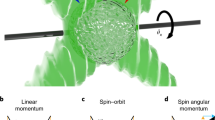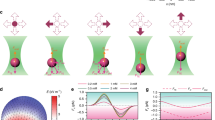Abstract
Light-induced rotation of absorbing microscopic particles by transfer of angular momentum from light to the material raises the possibility of optically driven micromachines. The phenomenon has been observed using elliptically polarized laser beams1 or beams with helical phase structure2,3. But it is difficult to develop high power in such experiments because of overheating and unwanted axial forces, limiting the achievable rotation rates to a few hertz. This problem can in principle be overcome by using transparent particles, transferring angular momentum by a mechanism first observed by Beth in 19364, when he reported a tiny torque developed in a quartz ‘wave-plate’ owing to the change in polarization of transmitted light. Here we show that an optical torque can be induced on microscopic birefringent particles of calcite held by optical tweezers5. Depending on the polarization of the incident beam, the particles either become aligned with the plane of polarization (and thus can be rotated through specified angles) or spin with constant rotation frequency. Because these microscopic particles are transparent, they can be held in three-dimensional optical traps at very high power without heating, leading to rotation rates of over 350 Hz.
This is a preview of subscription content, access via your institution
Access options
Subscribe to this journal
Receive 51 print issues and online access
$199.00 per year
only $3.90 per issue
Buy this article
- Purchase on Springer Link
- Instant access to full article PDF
Prices may be subject to local taxes which are calculated during checkout




Similar content being viewed by others
References
Friese, M. E. J., Enger, J., Rubinsztein-Dunlop, H. & Heckenberg, N. R. Optical angular-momentum transfer to trapped absorbing particles. Phys. Rev. A 54, 1593–1596 (1996).
He, H., Friese, M. E. J., Heckenberg, N. R. & Rubinsztein-Dunlop, H. Direct observation of transfer of angular momentum to absorptive particles from a laser beam with a phase singularity. Phys. Rev. Lett. 75, 826–829 (1995).
Simpson, N. B., Dholakia, K., Allen, L. & Padgett, M. J. Mechanical equivalence of the spin and orbital angular momentum of light: an optical spanner. Opt. Lett. 22, 52–54 (1997).
Beth, R. A. Mechanical detection and measurement of the angular momentum of light. Phys. Rev. 50, 115–125 (1936).
Ashkin, A., Dziedzic, J. M., Bjorkholm, J. E. & Chu, S. Observation of a single-beam gradient force optical trap for dielectric particles. Opt. Lett. 11, 288–290 (1986).
Constantinescu, V. N. Laminar Viscous Flow (Springer, New York, 1995).
Acknowledgements
This work was supported by the Australian Research Council.
Author information
Authors and Affiliations
Corresponding author
Rights and permissions
About this article
Cite this article
Friese, M., Nieminen, T., Heckenberg, N. et al. Optical alignment and spinning of laser-trapped microscopic particles. Nature 394, 348–350 (1998). https://doi.org/10.1038/28566
Received:
Accepted:
Issue Date:
DOI: https://doi.org/10.1038/28566
This article is cited by
-
Coherent manipulation of optical energy density of two-wave interference in atomic medium
Journal of Optics (2023)
-
Coherent manipulation of optical magnetic spin angular momentum of two-wave interference in atomic medium
Journal of Optics (2023)
-
Generation of two kinds of optical chains with multi-zone fan-shaped filter
Journal of Optics (2023)
-
Light-driven single-cell rotational adhesion frequency assay
eLight (2022)
-
Study of the variation of the optical properties of calcite with applied stress, useful for specific rock and material mechanics
Scientific Reports (2022)
Comments
By submitting a comment you agree to abide by our Terms and Community Guidelines. If you find something abusive or that does not comply with our terms or guidelines please flag it as inappropriate.



